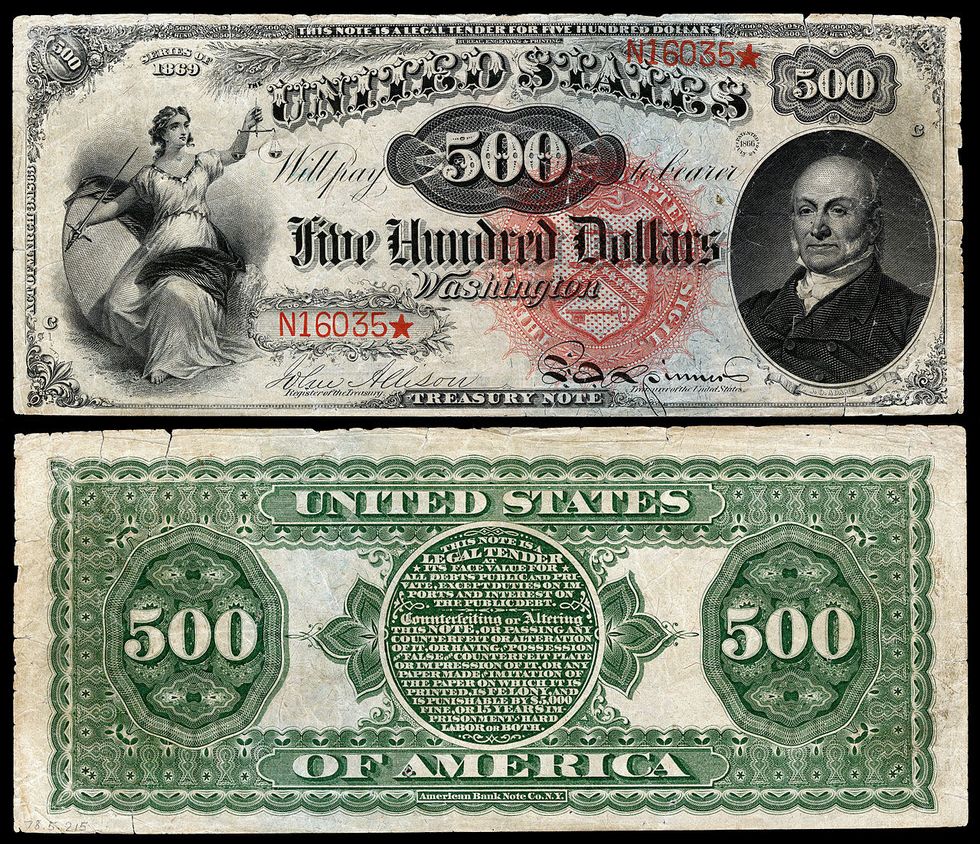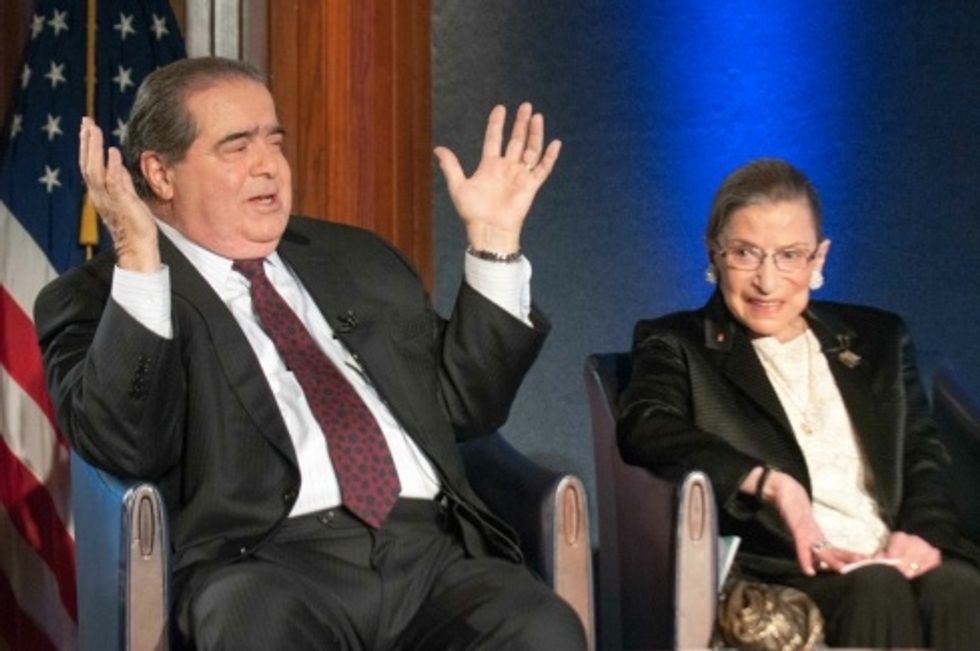You probably know who Ruth Bader Ginsburg is. Her likeness has been splashed all over trendy t-shirts and art and her workouts have become a national obsession. But did you know that before she was appointed there were only bathrooms onsite at the Court––for men? After she joined, they added a women’s bathroom so she and her female comrade Sandra Day O’Connor no longer had to hoof it back to their chambers. This nugget is just one of the many intriguing trivia about the Supreme Court most people don’t know. Want to learn more? Read on.

Dollah bills y’all
While neither bill is in circulation today, the $500 and $10,000 bill both sported an image of a previous chief justice. John Marshall and Salmon P. Chase were both memorialized forever on these federal notes. Sadly, the $500 and $10,000 bill went out of circulation in 1880 and 1878, respectively, but there’s still hope for future Supreme Court justices: with inflation perhaps we’ll see the return of higher denomination bills.
Diversity isn’t their strong suit
Out of the 112 justices that have served throughout the Supreme Court’s 229-year history, only four have been women. Sonia Sotomayor (who is also the first Latino justice), Ruth Bader Ginsburg, Sandra Day O’Connor, and Elena Kagan are the only females to have served on the Court. To date, there have only been two African Americans and one Latino. Their educational credentials are almost exclusively Ivy League to boot. Looks like they could stand to shake things up a bit.
Career dedication
Once appointed, justices of the Supreme Court serve for life. That said, fewer than half of them have died while serving. (Judge Antonin Scalia is the most recent judge to have passed while still appointed; most of them retire long before they shuffle off this mortal coil.) Right now the average retirement age is almost 80 years old. Some critics of this lifelong employment policy argue that there should be a maximum age at which mandated retirement kicks in. They posit that due to age-related mental decline, septuagenarian and octogenarian justices cannot be relied upon to issue the rulings that require a sharp mind. Tell that to Ruth Bader Ginsburg, the current oldest justice. At 85 years young, she’s still sharp as a tack and not considering retirement any time soon.
Lucky number nine
While nine justices sit on the bench today, it has not always been this way. George Washington appointed just six justices for the first incarnation. Even so, only three made the journey to the Royal Exchange in New York when they first convened in 1790. In 1807 they upped the tally to seven; thirty years later it grew to nine. By 1863 there were ten sitting justices, and while Congress unsuccessfully lobbied to go back to seven members, they eventually settled for nine in 1869.
Age ain’t nothing but a number
The average age of the current sitting justices is around 68. Due to the extensive experience needed to perform the job, justices are frequently past middle age when appointed. That said, the youngest one was Joseph Story, who joined the Supreme Court at the ripe age of 32. This happened in 1812, however, when 32 was considered middle age. The oldest appointed justice of the Supreme Court, Charles Evans, was 67, and he went on to serve 11 years.

Hoop dreams
Their current address in Washington, DC is home to two courts: legal and basketball. Informally referred to as “the highest court in the land,” this sports arena is where justices, clerks, police, and cafeteria workers come to relieve stress and shoot some hoops. If you’re dying to play HORSE with Sonya Sotomayor, you’re out of luck – it’s only open to previously mentioned select federal employees. And as a reward for their workouts, justices can always stop by the frozen yogurt machine in their cafeteria!

Behind the robes
While as a group the Supreme Justices can appear staid and impassive, when not on the bench they are free to express their livelier sides. Antonin Scalia was well known for his gregarious nature, handing out candy on Halloween at the court and often mingling with high-flyers at White House Correspondents’ Association dinners and the famed Alfalfa Club. Sonia Sotomayor is another social butterfly. She’s known for being outgoing and friendly and was considering turning down the Supreme Court position because she was concerned how it would impact her social life. Even Clarence Thomas, the least loquacious of the current justices, has a reputation for being friendly and open to his colleagues and coworkers. He allegedly knows every staffer’s name and is the “favorite” justice in the Supreme Court building.
On occasion, you’ll find some or all of the justices out in public together, most frequently at a cultural event. The Shakespeare Theatre Company puts on an annual production, which puts classic plays on trial. It is here that you’re most likely to see all of them out in one place. Some are even friends outside of work. Scalia and Ruth Bader Ginsberg shared a passionate love of opera, and despite their opposed political ideologies, vacationed together for years.
And you thought the federal government didn’t pay well
Supreme Court justices make almost $250,000 per year, more than the vice president. The chief justice receives almost $260,000. Due In part to this generous salary, many of the current justices are relatively rich, with six out of the nine estimated to be worth over $1 million. Steven Breyer is the wealthiest, with an estimated net worth of over $6 million. Ginsberg and Chief Justice Roberts are close behind, both estimated to be worth around $4 million.
Home sweet home
Congress established the Supreme Court in 1789, but it wasn’t always located on First Street NE in Washington, DC. It first convened in New York City, but after a few ill-attended sessions, moved to Philadelphia, the country’s capital at the time. During its Philadelphia tenure, the beleaguered justices often traveled the country hearing cases at circuit courts, which meant that court cases were often postponed due to travel delays or illness. In 1800 the Court moved to Washington, DC, but still had no official home. The current location only became permanent in 1935; from 1800-1935, court was often held in various rooms in the Capitol, or even in taverns and private homes.
The Supreme Court has a rich and storied history. When the founding fathers created it as the third crucial part of a fledgling government, they bestowed the appointed individuals with great power. Happily, today the justices continue to treat the position with the reverent respect that it deserves. It will be celebrating its 230th year in 2019, so we can all look forward to new, quirky, truths about the legendary Supreme Court.
- 11 Wacky Supreme Court Facts: Frozen Yogurt Justice, Scalia and … ›
- 7 Strange, Often Overlooked Supreme Court Facts – U.S. Supreme … ›
- What are some odd, interesting, or important U.S. Supreme Court … ›
- US Supreme Court Trivia | Fun Facts About SCOTUS ›
- 10 fascinating facts about the Supreme Court on its birthday … ›
- Supreme Court – Facts & Summary – HISTORY.com ›
- (Slightly) Astounding Facts About the Supreme Court ›
- 5 facts about the Supreme Court | Pew Research Center ›
- 10 Things You Didn’t Know About the Supreme Court | National … ›
- US Supreme Court Fast Facts – CNN ›





